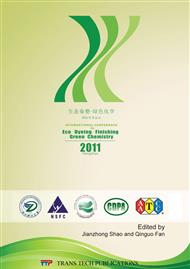p.226
p.231
p.235
p.239
p.244
p.249
p.255
p.261
p.266
A Study on Process Parameters for Imparting Hydrophobic Effect on Cotton Fiber with CF4-Plasma Treatment
Abstract:
The acquisition of hydrophobic surface offering liquid repellency is exploitable for diverse applications. This study examined the possibility of developing hydrophobic cotton fiber by employing atmospheric pressure plasma technique which is an environmentally friendly approach. We seek to determine a controlled hydrophobic modification of textile materials through the optimization of the fabrication process. A hydrophobic surface modification of cotton fabric was conducted with atmospheric pressure plasma using tetrafluoromethane (CF4) as the reactive gas. The resultant hydrophobic behavior was quantified macroscopically by a wetted area measurement. To control the degree of modification of the substrate, an orthogonal experimental design technique was utilized. The optimum process conditions were established based on the reduction of the wetted area of the plasma-modified fabrics.
Info:
Periodical:
Pages:
244-248
Citation:
Online since:
January 2012
Authors:
Price:
Сopyright:
© 2012 Trans Tech Publications Ltd. All Rights Reserved
Share:
Citation:


